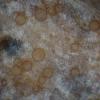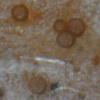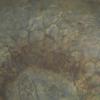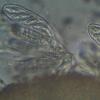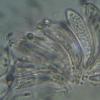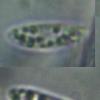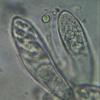
04-01-2026 17:45
 Stephen Martin Mifsud
Stephen Martin Mifsud
I was happy to find these orange asmocyetes which

03-01-2026 13:08
Niek SchrierHi all,We found groups of perithecia on a Lecanora

29-12-2025 17:44
Isabelle CharissouBonjour,J'aimerais savoir si d'autres personnes au

02-01-2026 17:43
MARICEL PATINOHi there, although I couldn't see the fruitbody, I

01-01-2026 18:35
Original loamy soil aside a artificial lake.The co

31-12-2025 19:27
Collected from loamy soil, at waterside (completel
Discomycète s/ Comarum palustre.
Luc Bailly,
08-02-2012 18:07
Apothécies -> 0.2 mm, en groupes importants, apparemment émergées, chamois clair, sessiles, lisses, à hyménium plan, plus clair, et à marge brun plus vif, mince. Consistance coriace.
Asques 8-sp., sp. bisériées, courts, hyalins, à crochets, IKI BB fort. Peu de spores mûres: sp. guttulées, hyalines, peut-être immatures, 11-12.5 x 3-3.5 µ.
Paraphyses hyalines, renflées au sommet x 3-4 µ, avec une grosse guttule bien réfringente au sommet.
Excip. ectal text. ang. émoussé, brun clair, plus foncé à la marge et près du point d'attache.
Aucune idée...
Amitiés - LUC.
Hans-Otto Baral,
08-02-2012 18:16

Re : Discomycète s/ Comarum palustre.
Hi Luc
intersting collection! I have only Aivenia tantula in my database for Comarum which appears similar, but spores are only 6-7 x 1.3-1.5.
Mollisia minutissima and Pyrenopeziza comari also exist.
There is a refractive VB in the paraphysis apex. Together with the remaining characters this reminds me of a Calloriella (= Crustomollisia), though a brown cloddy exudate is not visible on the excipulum.
Zotto
intersting collection! I have only Aivenia tantula in my database for Comarum which appears similar, but spores are only 6-7 x 1.3-1.5.
Mollisia minutissima and Pyrenopeziza comari also exist.
There is a refractive VB in the paraphysis apex. Together with the remaining characters this reminds me of a Calloriella (= Crustomollisia), though a brown cloddy exudate is not visible on the excipulum.
Zotto
Luc Bailly,
08-02-2012 18:36
Re : Discomycète s/ Comarum palustre.
Hi Zotto,
This is a nature reserve I often visit, so it's likely I can find more samples.
I do see brown exudates on the photo of the ectal excipulum. Quite clear brown though.
With the paraphyses, and the excipulum text. ang., I excluded Mollisia and Pyrenopeziza.
Calloriella is a genus I haven't seen yet, so, difficult to say. All I have in my refs is a Stip's photo of C. umbrinella on Solidago, and yes, there are similarities (paraphyses, excipulum) with that genus. Is there a study available on Calloriella?
Many thanks, cheers - LUC.
This is a nature reserve I often visit, so it's likely I can find more samples.
I do see brown exudates on the photo of the ectal excipulum. Quite clear brown though.
With the paraphyses, and the excipulum text. ang., I excluded Mollisia and Pyrenopeziza.
Calloriella is a genus I haven't seen yet, so, difficult to say. All I have in my refs is a Stip's photo of C. umbrinella on Solidago, and yes, there are similarities (paraphyses, excipulum) with that genus. Is there a study available on Calloriella?
Many thanks, cheers - LUC.
Chris Yeates,
08-02-2012 20:22

Re : Discomycète s/ Comarum palustre.
Bonsoir Luc
there are similarities between your disco and the one in the post I made on another fungus, for which Zotto pointed me towards Calloriella / Crustomollisia (mine was much more encrusted though) http://www.ascofrance.com/search_forum/16442
I shall follow this with interest
Amitiés
Chris
there are similarities between your disco and the one in the post I made on another fungus, for which Zotto pointed me towards Calloriella / Crustomollisia (mine was much more encrusted though) http://www.ascofrance.com/search_forum/16442
I shall follow this with interest
Amitiés
Chris
Luc Bailly,
08-02-2012 20:31
Re : Discomycète s/ Comarum palustre.
Hi Chris,
Thanks for this ref. Yes, my sample is quite close. I didn't notice the paraphyses' reaction to IKI though. My sample is less incrustated, and paler. But this aside, it seems to me Calloriella is a possibility.
Cheers - LUC.
Thanks for this ref. Yes, my sample is quite close. I didn't notice the paraphyses' reaction to IKI though. My sample is less incrustated, and paler. But this aside, it seems to me Calloriella is a possibility.
Cheers - LUC.
Hans-Otto Baral,
08-02-2012 20:37

Re : Discomycète s/ Comarum palustre.
I did not speak of an IKI-reaction of the paraphyses, only of very ?striking refractive vacuoles in the apical cell which disappear in the dead state and which you will therefore hardly find mentioned in the literature. But they are very typical for Calloriella.
Zotto
Zotto




